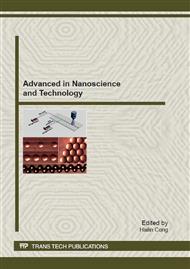p.141
p.146
p.150
p.155
p.160
p.165
p.172
p.178
p.182
Regenerated Antheraea pernyi Silk Fibroin Nanofiber Film
Abstract:
Regenerated Antheraea Pernyi silk fibroin (ASF) solution was prepared by dissolving Antheraea Pernyi (A. pernyi) silk fiber in lithium thiocyanate solution. Atomic force microscopy (AFM) examination showed that there were many short nanofibers in regenerated ASF solution, which were made up of 10-20 nm nanospheres. In this paper, we discussed the formation mechanism of these nanofibers. The results of the surface tension showed that ASF had surface active and can significantly decline the surface tension of water from 73 mN/m to 51 mN/m. The hydrophobic side chains of ASF molecular would try to break away from water environment and thereby undergo self-assembly into nanospheres. And then, these nanospheres arrange into a short nanofiber. Then, the ASF nanofiber film was prepared by casting regenerated ASF solution blended with glycol. The structure of ASF was β-sheet and the film was water-insoluble. This blend film not only had excellent mechanical properties, but also can be biodegradated by enzyme in vitro. All of this indicated that this new regenerated ASF nanofiber film not only provided excellent biocompatibility, but also had large surface as extracellular matrix (ECM) to cell adhesion. The film made of nanofiber was similar to ECM on the nanoscale, which promoted cell migration and proliferation. In summary, it provided a great potential as a biological material.
Info:
Periodical:
Pages:
160-164
Citation:
Online since:
February 2012
Authors:
Keywords:
Price:
Сopyright:
© 2012 Trans Tech Publications Ltd. All Rights Reserved
Share:
Citation:


